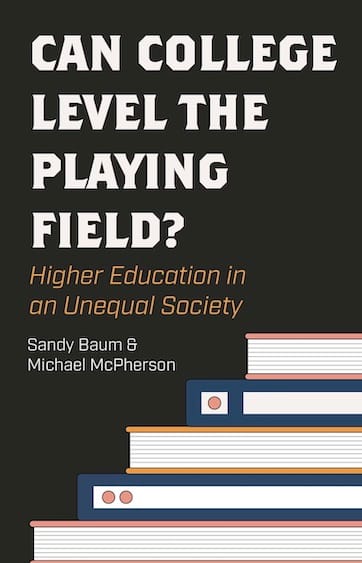The context for much of what I think about on this site is articulated in the central question of this important book: In an unequal society, to what extent can college level the playing field?

The authors' answers are similar to mine. They write in Chapter Three of the central tension of the promise of higher ed:
Children from low-income backgrounds are much more likely to rise above the economic status of their parents if they complete college degrees than if they end their education after high school. However, college outcomes are a central factor in leading children from high-income families to preserve their advantage. In a society where opportunity to prepare for a demanding college education are so unevenly distributed, gaps in participation and success in higher education help to explain this apparent contradiction. (p. 42)
Chapter by chapter, data point by data point, Baum and McPherson document inequalities that shape peoples' lives:
- In early childhood: more than in most other Western nations, children in the U.S. are raised within housing and food insecurity, with limited access to early childhood education, within fragile social safety nets and the stresses of under-resourced communities.
- In the K-12 schooling years: Underfunded schools are increasingly segregated by race and class, middle-class parents invest in competitive advantages for their own children outside of K-12 schools, teacher labor markets steer the most experienced teachers to middle-class schools while leaving low-income students taught by the least experienced. Many students have access to only the bare minimum information about choosing and applying to colleges.
- During college: The serious underfunding of community colleges (and in too many states, four-year colleges) leaves poor and working-class students with too few resources for catching up with peers. Financial aid does not cover living expenses and the few support programs for low-income students are starved of resources. Privileged parents leverage their advantages for their children for internships, study abroad, and summer jobs in prestigious settings. Selective colleges spend much more on the few students they admit than can be spent for students at open-enrollment schools, as if lower-income students with fewer college choices don't deserve greater investments.
- And after college: Hiring practices mean persistent income inequalities between elite college and other college graduates, between men and women, between people of color and white people; wages even for college graduates lag increases in the costs of living; tax policies favor the rich.
So what's to be done?
As concisely as they document the layers of inequalities through which students wade to get to and through college, Baum and McPherson also recommend policy solutions: Childhood supports, school funding, higher-education funding, and also, importantly, universities becoming involved in solving the problems of inequalities within their own communities. None of this can be done without also educating all students about both their own hidden advantages and about policies to level playing fields.
I believe firmly that poor and working-class students could lead such projects of educating peers (and faculty) about inequalities just beyond campus, but even these students learn little about the circumstances of their own lives. Low-income students invested in evading classism on campus by hiding their backgrounds are not interrogating the politics of inequalities. First-generation students applauded for their "resilience" are not learning to question why they had to be so resilient as children. First-generation students applauded as role models for the rewards for hard work are not often invited to talk openly about their communities where people work very hard but cannot get ahead. Faculty who deem their own class privileges irrelevant to their choices around teaching and scholarship have no incentive for engaging in work that addresses structural economic inequalities.
The book is rich with data, deeply referenced, and in the end, optimistic that we can solve problems that we are willing to see. And that "willing to see" remains a central challenge within campus cultures organized around myths of merit and opportunity.




